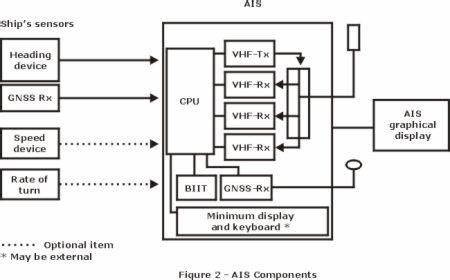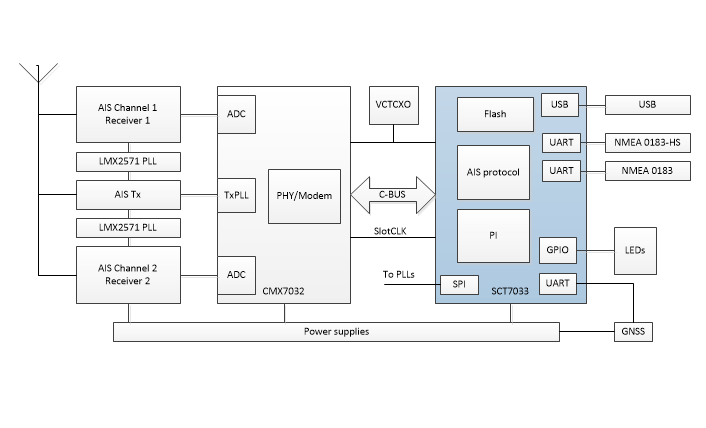When introduced in the mid-nineties by the International Maritime Organisation, (IMO), the Automatic Identification System, (AIS), was aimed at maritime collision avoidance and monitoring of shipping. By continuously broadcasting information over public airwaves using unencrypted VHF radio signals, AIS enables the identity and position of nearby ships to be displayed on a screen or an electronic chart display and information system (ECDIS).
Due to its physical size, complexity and power requirements, the initial AIS version, Class A, was only mandated for larger vessels. Then, in 2006, the AIS Class B specification was released, enabling the production of simpler and lower cost devices suitable for smaller vessels, such as leisure craft and fishing boats. The popularity of Class B devices has led to an increase in the installed base of AIS transceivers, in turn driving growth in the number and variety of applications running over the AIS infrastructure. By using the 6 different types of Application Specific Message, (ASM), included in the AIS specification applications can exchange data, using the AIS stations as modems, without disrupting the basic AIS functionality.
Emerging AIS Applications Drive Opportunities
This capability, along with access to low-priced satellite communications, has seen AIS evolve into a tool that can be used for a wide variety of applications, including homeland security, weather forecasting, fisheries monitoring, marine conservation, invasive species transport, and many more.
Fisheries protection, for example, has become a priority in recent years, particularly in developing countries where Illegal Unreported and Unregulated, (IUU), activities threaten both fish stocks and the local economies. Following Indonesia’s success using Vessel Monitoring Systems, (VMS), to drastically reduce the levels of IUU in its waters, many other governments are looking to mandate the installation of AIS on their fishing fleets.
There is therefore a significant opportunity for manufacturers of AIS systems as emerging applications such as IUU monitoring and others drive further deployments of AIS. However, with incomes low in many of the countries launching these applications, it is highly likely that subsidies will be required to ensure that local fleets comply with new regulations. AIS equipment manufacturers wishing to target these growing markets must therefore not only be nimble but must also be capable of building AIS Class B functionality into their devices at very low cost.
Pre-Integrated Devices Reduce Development Costs and Time-to-Market
Designing an AIS system from scratch however can be a complex and time-consuming process, requiring a wide mix of skills and knowledge. An AIS transceiver, figure 2, integrates RF functionality, digital processing capabilities and a variety of interfaces to devices such as radar/Automatic Radar Plotting Aids (ARPA), Electronic Chart System/Electronic Chart Display and Information System (ECS/ECDIS) and Integrated Navigation Systems (INS)

Figure 2: Generic AIS Block diagram
Source: (http://solasv.mcga.gov.uk/Annexes/Annex17.htm)
In addition, AIS Class B devices use the complex Carrier Sense Time-Division-Multiple-Access, (CSTDMA) modulation scheme and must meet the requirements of IEC 62287-1, governing Spectrum Usage and Access to Emergency Services.
With time-to-market critical it is not always practical for the developer to spend time acquiring the skills and knowledge, necessary to design an AIS unit from the “ground up”, the focus must be on rapidly developing the product. Manufacturers who do not have the requisite skills in-house can overcome these limitations and still capitalise on the growing AIS market opportunities by basing their system designs on devices which pre-integrate the AIS functionality, such as the SCT7033 AIS Class B Protocol Stack Processor from CML Microcircuits.
CML’s AIS Expertise Simplifies the Design Process
Developed specifically to support AIS applications, the SCT7033, figure 3, embeds the full AIS Class B CSTDMA protocol stack and is IEC 62287-1 compatible and ITU-R M.1371-5 compliant. The device is programmable across the full marine band, (156.000 to 162.050 MHz), and implements a dual-channel receiver and single transmitter. The SCT7033 also provides flexible interfacing to GNSS receivers, NMEA0183 marine communications bus, status LEDs and USB/UART interfaces.

Figure 3: SCT7033 block diagram
(Source: CML Micro)
With the SCT7033 taking care of the AIS protocols, developers with no experience of AIS can focus on differentiating their product through system-level features, rather than having to understand and then develop a standard protocol. Basing new product development on the SCT7033 simplifies both the design phase and the certification process, significantly reducing development expense and enabling faster time to market for a compliant transponder.
AIS is becoming an enabling tool for an emerging class of applications and opportunities exist for manufacturers of AIS equipment, but only if they can deliver fully compliant devices at the right cost. CML Micro are global leaders in marine radio applications, including AIS, with their ICs found in an increasing range of voice and data communication equipment used in marine safety applications. Manufacturers integrating CML Micro’s products, such as the SCT7033, into their designs benefit from the depth of CML Micro’s experience in AIS and significantly reduce their development costs and time to market.




